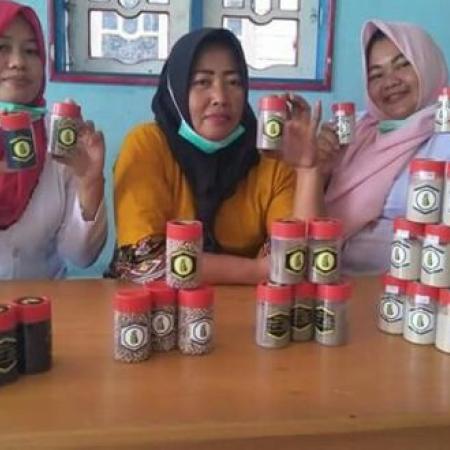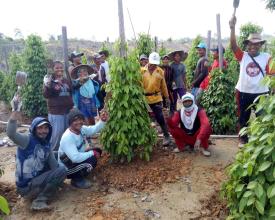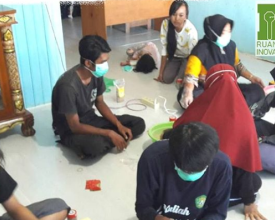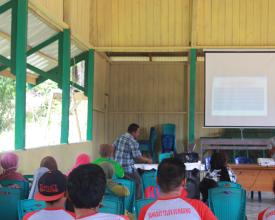
Sustainable Agriculture with Cutting Edge Applicable Technology

Developing agribusiness area as a competitive option for the farmers/people who lives surrounded by mining and palm oil area is a very simple idea and easy to practice for the rural people. Through development of sustainable farming combined with innovation of post harvest products, the revenue of this activity can become very competitive compared to sacrificing their land to be converted to mining and palm oil plantation area for big companies. We believe by practicing sustainable agribusiness, the people can protect their ecosystem along with increasing their life quality financially. This concept is what we’re going to implant to the youths through practice. Together, with help of local government, civil society, and business, we encourage the youths to keep innovating in the sector of agriculture and post harvest processing as the best choices to protect their ecosystem and their future.
Context
Challenges addressed
- Hard to communicate the development concept to local people
- The political situation might vary locally and regionally
- Hard to motivate the youth to do product innovation when there's a risk to fail commercially.
Location
Process
Summary of the process
First step of agribusiness development in Merancang Ilir, we conducted participatory mapping that also contains political criteria/factor thus we have internal analysis to intervene with village development. We carefully picked the key person in order to minimize internal conflict within the village. The final results of the mapping is giving a legitimation of farmers to have their own agribusiness area and it’s synchronized to village development plan. After we helped to organize farmers, we helped to organize group of farmers’s wives to have a village owned company, Pondok Lada. Right now we’re focusing on producing post harvest product of pepper, graded pepper berries and pepper powder. We also facilitate to do increase management of Pondok Lada to be more professional company, such as simple accounting training, creating a business plan, marketing strategies, etc. Currently we’re also helping to run a village level research and development group focusing on how to increase the quality of peppers, conducting research of intensification of fish farming, and creating organic fertilizer through the waste of fish farming in order to have sustainabillity aspect, organic farming.
Building Blocks
Participatory Mapping combined with Integrated Geographical Information System
Merancang Ilir is located on the side of Segah River in Berau District, East Kalimantan, Indonesia. The river is one of the biggest rivers in Berau. It is usually used by palm oil and coal mining company barge ships to carry Crude Palm Oil (CPO) and coal. Majority of the villages administration area across this river is acquired by those companies up to 80% of its administration area. But Merancang Ilir is a unique village, the people still believe that without those companies the people still have prosperity through agriculture. They also believe that by letting those companies in, it will not answer how to increase economic equality. To support those dreams we intend to help them to be economically independent in agriculture system. Before we begin to act, we need to do participatory mapping to gain more detailed knowledge of the current potential and problems of the village. Using GIS and conducting its basic training for the villagers, the people can establish strategies of development based on sustainable agriculture and agribusiness.
Enabling factors
- The village and its administration understand the concept and basic technique of mapping its potential resources after GIS basic training was held by us.
- From the results of the mapping, the village understands how to construct a medium term plan.
- Village administration understand about rules of village development area (conservation area, agribusiness area, and research area).
- The villagers understand the concept and the mission from those plans and become active actors for their execution.
Lesson learned
- Using the most familiar and simplest words and deconstructing complex ideas into bricks of simple example and analogy to be explained to local people.
- The locals understand how to construct a mapping plan, such as which data they are gathering, how to compile those data, and how to make basic analysis of those data and implement it into local policies and village development plan.
- Besides spatial (general information of geographical condition and administrative border), social (general information of population profile), and sectoral mapping (specific information of village potential or condition such as agriculture, education, health, etc), key leader mapping must be executed in order to run the program smoothly; in addition, the next person in charge/leader must be from the local community to ensure the future sustainability of the program.
- Understand which government agencies need to be collaborated with and how to establish a good relationship between the village and those agencies.
Establishment and Development Support of Village Level Organizations.
From the execution of the participatory mapping and creation of medium term planning, it’s required to have short term follow up action plans such as:
1. Making the union of farmers, village owned company (Pondok Lada), research group is legally recognized both locally and nationally,
2. Support annual strategies that based on medium term planning, such as:
a. Farmers union is to increase the annual harvest volume, not expand their agriculture in water source protection area, using organic pesticide and fertilizer, grading pepper berries to be sold to the company, Pondok Lada.
b. The company buy graded pepper berries with the fair price that is disscussion with farmers union, producing post harvest product as a instant product, gradually transform to eco-packaging to reduce the impact of plastic waste.
c. Research group to teach how to grade pepper with global standard, teaching how to integrate each type of farming (pepper, fishery) by supplying each other nutrition.
This annual planning that is arranged by village has to be synchronized to district and national medium and long term planning in order to have better support from the government.
Enabling factors
- Legalization of formed groups (the company, research groups) regionally to nationally.
- Creating key persons and support system for regeneration of those groups.
- Synchronization of annual strategies of those groups to village administration medium term planning, medium and long term regional to national government level planning with collaborations with other local movements, academics, start-up companies, NGOs, etc.
- Coordination and data sharing with related government institutions to gain support from the planning that is arranged by village.
Lesson learned
- Understand how the line of coordination and legal system works in different regions
- Collected of various policies, (i.e long term agricultural development plan from Ministry of Agriculture, long term agricultural and energy development plant from province level) to be synchronized to village development plan from each level of government, i.e (National or Regional) Planning and Development Ministry, Village Empowernment Ministry (regional), Agriculture Ministry.
- Know the key person of each sector from the government, NGOs, academics, i.e. head of directorate of development rural area in National or Regional) Planning and Development Ministry.
Product Innovation and Development Using Applied Technology
The continuation of organizing every group of the village is to hold a training and development of post farm production such as improving quality of raw materials, packaging, marketing, and research and development. Applicable technology (i.e. fish farming intensification (biofloc), fish food production using pepper and rice farm waste supported mechanical processing, organic fertilizer using processed waste of fish farming, etc) is required and it has to be simple technology so that the people can operate, maintain, and even build the machine itself. Widening the range of market and technology information can be obtained from training events and various exhibitions. Up until the final stage that the local people are fully capable to execute and develop themselves. The future evolving technology that is going to be applied in the village has to be controlled so it doesn't exceed its biocapacity(an estimation of capacity given to an ecosystem/biological productive area to absorbs waste and produce natural resources).
Enabling factors
- Executing initial research of post farm product development and application of applied technology
- Widening the distribution of those products to big cities nearby.
- Product development with various practical and modern packaging
- Green packaging development to eco-friendly material/plastic subtitute material (i.e using plastic subtitute package, such as, plastic from sea weed, maizena, etc).
- Product innovation (i.e. powder, essential oil, etc) to create more variety of products and increasing brand value
- Network expansion to export market
Lesson learned
- Understand which local companies we're going to collaborate with and regional distribution line.
- Discover various organic community and product innovation, green packaging innovation, and applied technology to support these.
- Enriching product and market knowledge and its legal barrier so we can improve human capacity to overcome those challenges.
- Using up to date media as marketing strategies (online marketing) so increasing information tech savviness is mandatory for villagers.
Impacts
- People know about their own ecological capability and how they should live their life more healthily and sustainably.
- People know about the importance of the legal status of their land before illegal land grabbing happened.
- People know how to manage their land and development plan using integrated geographic information system. By participatory mapping, people know how their local ecosystem behaves, thus increasing knowledge on how to conserve it for their next generations.
- By creating legalizing their policy, villagers can have legal security from inside threat, e.g land monopoly and outside threats, e.g land acquisition by palm oil and mining companies.
- By identifying farmers as the economic foundation of the village, officials must have supported their needs to solve problems with collaboration with their research community. The solutions was indeed according to sustainable planning guldelines that are agreed together.
- Officials and farmers together hold the responsibility together, minimalize blaming each other.
- Upgrading biocapacity and human capacity to keep up with technological challenges from the present and the future.
- Open up knowledge about present and future opportunity to produce developed products. It can increase value in open market so it also increase local economy and local human capacity.
Beneficiaries
- It will benefit the local people themselves.
- local to national government level
- The youths (farmers, unemployed youths, intellectual)
- Investors
Sustainable Development Goals
Story

Ms Putri, a wife of the head villager is coordinating a group of farmers' wives to start a local scale company/UMKM, called Pondok Lada. She dreams that the prosperity of the pepper farmers will not go away as the raw pepper prices fluctuate greatly every year. So she initiate to increasing buying level of raw pepper using Pondok Lada. The group manages to buy raw pepper from farmers at a reasonable price so that the farmers can close their production cost and have a profit from the selling. Now to support the financing of Pondok Lada, along with the members of the group, she innovates some products that have never been created before, for example a pure pepper powder and highest quality of raw pepper.
To increase the brand value, she managed to get help to repackage the product so it can be easier to consume and easier to carry without losing the value of hygiene. Now, in less than a year Pondok Lada has attended various training sessions and exhibitions to increase the product value and promote the product and organizations. The products has been promoted through South East Asia Market in 4th IMT-GT & BIMPT-EAGA in Thailand last July 2018 and aimed to expand its market to attend Trade Expo Indonesia in October 2018.










